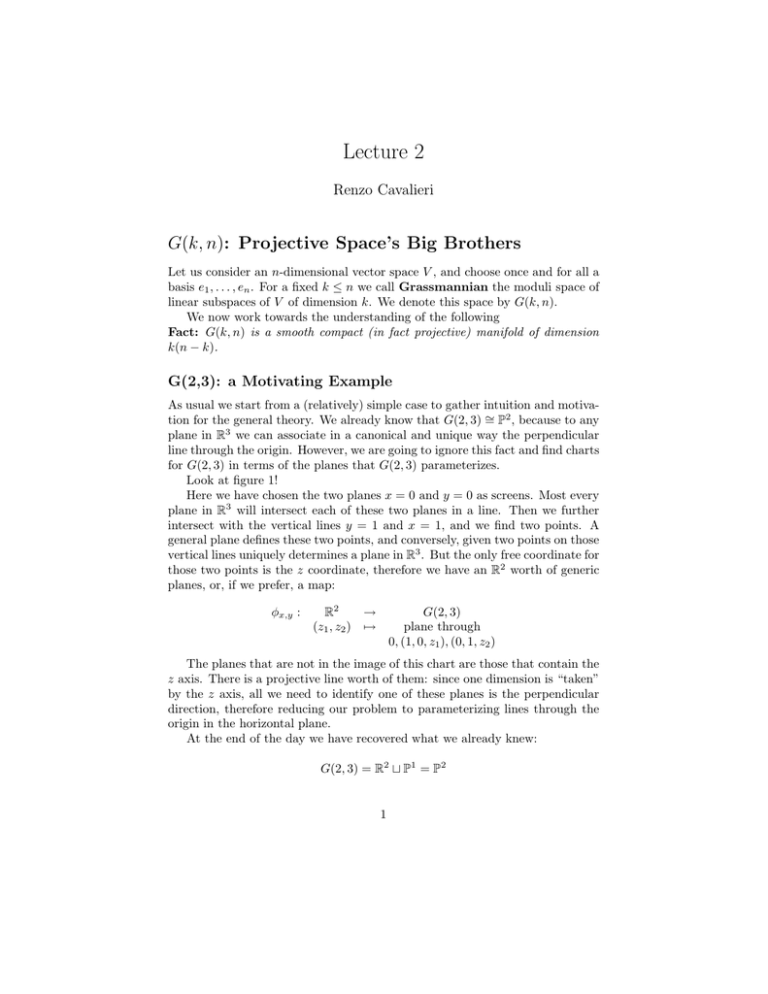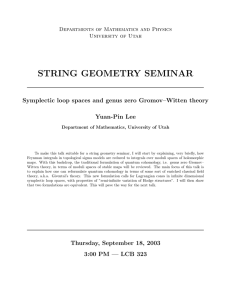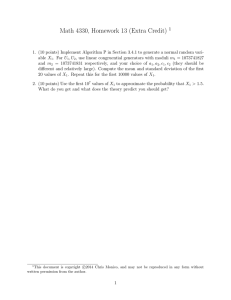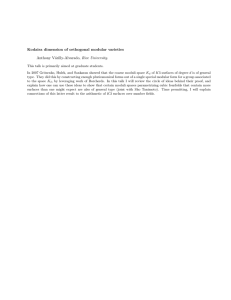Lecture 2 (k, n): Projective Space’s Big Brothers G Renzo Cavalieri
advertisement

Lecture 2
Renzo Cavalieri
G(k, n): Projective Space’s Big Brothers
Let us consider an n-dimensional vector space V , and choose once and for all a
basis e1 , . . . , en . For a fixed k ≤ n we call Grassmannian the moduli space of
linear subspaces of V of dimension k. We denote this space by G(k, n).
We now work towards the understanding of the following
Fact: G(k, n) is a smooth compact (in fact projective) manifold of dimension
k(n − k).
G(2,3): a Motivating Example
As usual we start from a (relatively) simple case to gather intuition and motivation for the general theory. We already know that G(2, 3) ∼
= P2 , because to any
3
plane in R we can associate in a canonical and unique way the perpendicular
line through the origin. However, we are going to ignore this fact and find charts
for G(2, 3) in terms of the planes that G(2, 3) parameterizes.
Look at figure 1!
Here we have chosen the two planes x = 0 and y = 0 as screens. Most every
plane in R3 will intersect each of these two planes in a line. Then we further
intersect with the vertical lines y = 1 and x = 1, and we find two points. A
general plane defines these two points, and conversely, given two points on those
vertical lines uniquely determines a plane in R3 . But the only free coordinate for
those two points is the z coordinate, therefore we have an R2 worth of generic
planes, or, if we prefer, a map:
φx,y :
R2
→
(z1 , z2 ) 7→
G(2, 3)
plane through
0, (1, 0, z1), (0, 1, z2 )
The planes that are not in the image of this chart are those that contain the
z axis. There is a projective line worth of them: since one dimension is “taken”
by the z axis, all we need to identify one of these planes is the perpendicular
direction, therefore reducing our problem to parameterizing lines through the
origin in the horizontal plane.
At the end of the day we have recovered what we already knew:
G(2, 3) = R2 ⊔ P1 = P2
1
Introduction to Moduli Spaces
UCR, San Jose’, Summer 2007
z
xxxxxxxxxxxxxxxxxxxxxxxxxxxxxxxxxxxxxxxxxxxxxxxxxxxxxxxxxxxxxxxxxxxxxxxxxxxxxxx
xxxxxxxxxxxxxxxxxxxxxxxxxxxxxxxxxxxxxxxxxxxxxxxxxxxxxxxxxxxxxxxxxxxxxxxxxxxxxxx
xxxxxxxxxxxxxxxxxxxxxxxxxxxxxxxxxxxxxxxxxxxxxxxxxxxxxxxxxxxxxxxxxxxxxxxxxxxxxxx
xxxxxxxxxxxxxxxxxxxxxxxxxxxxxxxxxxxxxxxxxxxxxxxxxxxxxxxxxxxxxxxxxxxxxxxxxxxxxxx
xxxxxxxxxxxxxxxxxxxxxxxxxxxxxxxxxxxxxxxxxxxxxxxxxxxxxxxxxxxxxxxxxxxxxxxxxxxxxxx
xxxxxxxxxxxxxxxxxxxxxxxxxxxxxxxxxxxxxxxxxxxxxxxxxxxxxxxxxxxxxxxxxxxxxxxxxxxxxxx
xxxxxxxxxxxxxxxxxxxxxxxxxxxxxxxxxxxxxxxxxxxxxxxxxxxxxxxxxxxxxxxxxxxxxxxxxxxxxxx
xxxxxxxxxxxxxxxxxxxxxxxxxxxxxxxxxxxxxxxxxxxxxxxxxxxxxxxxxxxxxxxxxxxxxxxxxxxxxxx
xxxxxxxxxxxxxxxxxxxxxxxxxxxxxxxxxxxxxxxxxxxxxxxxxxxxxxxxxxxxxxxxxxxxxxxxxxxxxxx
xxxxxxxxxxxxxxxxxxxxxxxxxxxxxxxxxxxxxxxxxxxxxxxxxxxxxxxxxxxxxxxxxxxxxxxxxxxxxxx
xxxxxxxxxxxxxxxxxxxxxxxxxxxxxxxxxxxxxxxxxxxxxxxxxxxxxxxxxxxxxxxxxxxxxxxxxxxxxxx
xxxxxxxxxxxxxxxxxxxxxxxxxxxxxxxxxxxxxxxxxxxxxxxxxxxxxxxxxxxxxxxxxxxxxxxxxxxxxxx
xxxxxxxxxxxxxxxxxxxxxxxxxxxxxxxxxxxxxxxxxxxxxxxxxxxxxxxxxxxxxxxxxxxxxxxxxxxxxxx
xxxxxxxxxxxxxxxxxxxxxxxxxxxxxxxxxxxxxxxxxxxxxxxxxxxxxxxxxxxxxxxxxxxxxxxxxxxxxxx
xxxxxxxxxxxxxxxxxxxxxxxxxxxxxxxxxxxxxxxxxxxxxxxxxxxxxxxxxxxxxxxxxxxxxxxxxxxxxxx
xxxxxxxxxxxxxxxxxxxxxxxxxxxxxxxxxxxxxxxxxxxxxxxxxxxxxxxxxxxxxxxxxxxxxxxxxxxxxxx
xxxxxxxxxxxxxxxxxxxxxxxxxxxxxxxxxxxxxxxxxxxxxxxxxxxxxxxxxxxxxxxxxxxxxxxxxxxxxxx
xxxxxxxxxxxxxxxxxxxxxxxxxxxxxxxxxxxxxxxxxxxxxxxxxxxxxxxxxxxxxxxxxxxxxxxxxxxxxxx
xxxxxxxxxxxxxxxxxxxxxxxxxxxxxxxxxxxxxxxxxxxxxxxxxxxxxxxxxxxxxxxxxxxxxxxxxxxxxxx
xxxxxxxxxxxxxxxxxxxxxxxxxxxxxxxxxxxxxxxxxxxxxxxxxxxxxxxxxxxxxxxxxxxxxxxxxxxxxxx
xxxxxxxxxxxxxxxxxxxxxxxxxxxxxxxxxxxxxxxxxxxxxxxxxxxxxxxxxxxxxxxxxxxxxxxxxxxxxxx
xxxxxxxxxxxxxxxxxxxxxxxxxxxxxxxxxxxxxxxxxxxxxxxxxxxxxxxxxxxxxxxxxxxxxxxxxxxxxxx
xxxxxxxxxxxxxxxxxxxxxxxxxxxxxxxxxxxxxxxxxxxxxxxxxxxxxxxxxxxxxxxxxxxxxxxxxxxxxxx
xxxxxxxxxxxxxxxxxxxxxxxxxxxxxxxxxxxxxxxxxxxxxxxxxxxxxxxxxxxxxxxxxxxxxxxxxxxxxxx
xxxxxxxxxxxxxxxxxxxxxxxxxxxxxxxxxxxxxxxxxxxxxxxxxxxxxxxxxxxxxxxxxxxxxxxxxxxxxxx
xxxxxxxxxxxxxxxxxxxxxxxxxxxxxxxxxxxxxxxxxxxxxxxxxxxxxxxxxxxxxxxxxxxxxxxxxxxxxxx
xxxxxxxxxxxxxxxxxxxxxxxxxxxxxxxxxxxxxxxxxxxxxxxxxxxxxxxxxxxxxxxxxxxxxxxxxxxxxxx
xxxxxxxxxxxxxxxxxxxxxxxxxxxxxxxxxxxxxxxxxxxxxxxxxxxxxxxxxxxxxxxxxxxxxxxxxxxxxxx
xxxxxxxxxxxxxxxxxxxxxxxxxxxxxxxxxxxxxxxxxxxxxxxxxxxxxxxxxxxxxxxxxxxxxxxxxxxxxxx
xxxxxxxxxxxxxxxxxxxxxxxxxxxxxxxxxxxxxxxxxxxxxxxxxxxxxxxxxxxxxxxxxxxxxxxxxxxxxxx
xxxxxxxxxxxxxxxxxxxxxxxxxxxxxxxxxxxxxxxxxxxxxxxxxxxxxxxxxxxxxxxxxxxxxxxxxxxxxxx
xxxxxxxxxxxxxxxxxxxxxxxxxxxxxxxxxxxxxxxxxxxxxxxxxxxxxxxxxxxxxxxxxxxxxxxxxxxxxxx
xxxxxxxxxxxxxxxxxxxxxxxxxxxxxxxxxxxxxxxxxxxxxxxxxxxxxxxxxxxxxxxxxxxxxxxxxxxxxxx
xxxxxxxxxxxxxxxxxxxxxxxxxxxxxxxxxxxxxxxxxxxxxxxxxxxxxxxxxxxxxxxxxxxxxxxxxxxxxxx
xxxxxxxxxxxxxxxxxxxxxxxxxxxxxxxxxxxxxxxxxxxxxxxxxxxxxxxxxxxxxxxxxxxxxxxxxxxxxxx
xxxxxxxxxxxxxxxxxxxxxxxxxxxxxxxxxxxxxxxxxxxxxxxxxxxxxxxxxxxxxxxxxxxxxxxxxxxxxxx
xxxxxxxxxxxxxxxxxxxxxxxxxxxxxxxxxxxxxxxxxxxxxxxxxxxxxxxxxxxxxxxxxxxxxxxxxxxxxxx
xxxxxxxxxxxxxxxxxxxxxxxxxxxxxxxxxxxxxxxxxxxxxxxxxxxxxxxxxxxxxxxxxxxxxxxxxxxxxxx
xxxxxxxxxxxxxxxxxxxxxxxxxxxxxxxxxxxxxxxxxxxxxxxxxxxxxxxxxxxxxxxxxxxxxxxxxxxxxxx
xxxxxxxxxxxxxxxxxxxxxxxxxxxxxxxxxxxxxxxxxxxxxxxxxxxxxxxxxxxxxxxxxxxxxxxxxxxxxxx
xxxxxxxxxxxxxxxxxxxxxxxxxxxxxxxxxxxxxxxxxxxxxxxxxxxxxxxxxxxxxxxxxxxxxxxxxxxxxxx
xxxxxxxxxxxxxxxxxxxxxxxxxxxxxxxxxxxxxxxxxxxxxxxxxxxxxxxxxxxxxxxxxxxxxxxxxxxxxxx
xxxxxxxxxxxxxxxxxxxxxxxxxxxxxxxxxxxxxxxxxxxxxxxxxxxxxxxxxxxxxxxxxxxxxxxxxxxxxxx
xxxxxxxxxxxxxxxxxxxxxxxxxxxxxxxxxxxxxxxxxxxxxxxxxxxxxxxxxxxxxxxxxxxxxxxxxxxxxxx
x=1
y=1
z1
z2
(z1 ,z 2 )
Π
x
y
Figure 1: A natural chart for G(2, 3).
2
Introduction to Moduli Spaces
UCR, San Jose’, Summer 2007
Problem 1. Find out the transformation between these charts for G(2, 3) and
the charts given by associating to a plane its perpendicular line and then using
the standard charts for P2 .
G(k,n) is a Manifold
Let us now try to generalize what we have done. We will do it in two ways.
Geometric Approach
What did we do in the previous section?
1. We chose k linear subspaces L1 , . . . , Lk of V of dimension n − k + 1. Each
of them intersects a general k-subspace of Rn in line. Let us call these
lines ℓ1 , . . . , ℓk .
2. Inside each of the Li , we chose a hyperplane Hi not through the origin.
At this point the intersection
Hi ∩ ℓi = Pi
is one point in an n − k dimensional linear space.
3. The coordinates of the Pi ’s inside the Hi ’s define the chart to the Grassmannian. Since we are free to choose k points inside n − k dimensional
linear spaces we see that the dimension of G(k, n) is k(n − k).
4. What are the k-subspaces that are not in the image of this chart? Those
that intersect any of the subspaces Li in more than just a line!
Algebraic Approach
If you prefer linear algebra here’s another approach. To give a k-subspace of
V you can simply give k linearly independent vectors v1 , . . . , vk ∈ V , or, if you
prefer, a (k × n) matrix of maximal rank:
v11 v12 . . . v1n
v21 v22 . . . v2n
A= .
..
..
..
.
.
.
.
.
vk1
vk2
. . . vkn
Of course there is a lot of redundancy in this description, because we can
choose to arbitrarily change the basis for our k-subspace. This corresponds to
multiplying A on the left by a matrix in GL(k). Now let us choose k columns,
for example the first k, just so we don’t get a headache with general notation.
3
Introduction to Moduli Spaces
If the determinant of the
unique matrix in Υ ∈ GL(k)
1
0
ΥA = .
..
UCR, San Jose’, Summer 2007
k × k minor is different from zero, then there is a
(namely the inverse of that minor) such that
0 . . . 0 v1(k+1) . . . v1n
1 . . . 0 v1(k+1) . . . v2n
..
..
..
..
..
..
.
.
.
.
.
.
0 0
... 1
vk(k+1)
. . . vkn
We see immediately that the remaining coefficients give local coordinates for
the chart, and that they correspond to a copy of Rk(n−k) .
What’s the Complement of a Chart?
Algebraically, the k-subspaces that are not parameterized in the chart above
are those such that the determinant of the chosen k × k minor vanishes.
For the particular chart above, this corresponds to k-subspaces that intersect
the space {x1 = x2 = . . . = xk = 0} in more than just a point. By distinguishing
all possible cases, you should now tackle the following
Problem 2 (Challenge).
G(k, n) = Rk(n−k) ⊔G(1, k)×G(k−1, n−k)⊔G(2, k)×G(k−2, n−k)⊔. . .⊔G(k−1, k)×G(1, n−k)
G(k,n) is Projective
We still need to veryfy that G(k, n) is compact. We do so by showing that
G(k, n) is a closed subvariety of an appropriate projective space.
Our approach is again to try and reproduce what we did with projective
space when we constructed homogeneous coordinates for Pn . As usual, rather
than going crazy with indices, let’s work with a specific example: G(2, 4).
Start from a point P ∈ G(2, 4), that we think as a 2 × 4 matrix A.
x1 y1 z1 w1
A=
x2 y2 z2 w2
We want to associate to this matrix a well chosen set of numbers. The
problem is, as usual, that A is not the only matrix that represents P . Any
matrix ΥA also represents the same point in G(2, 4), provided that Υ is an
invertible 2 × 2 matrix. Therefore we try and choose as coordinates numbers
that will be as unperturbed as possible by the multiplication by Υ.
Take the determinants of all 2 × 2 minors of the matrix A:
x y1 , . . . , z1 w1 (u0 , . . . , u5 )(A) = 1
x2 y2
z2 w2 What happens when you multiply on the left by Υ?
x1 y1 z
(u0 , . . . , u5 )(ΥA) = det(Υ) , . . . , det(Υ) 1
x2 y2
z2
4
w1 w2 Introduction to Moduli Spaces
UCR, San Jose’, Summer 2007
Yes! All numbers are multiplied by the same constant det(Υ)! This means
that this construction associates to a point in G(2, 4) a proportionality class of
sextuples - i.e., a point in P5 .
Problem 3. Show that in general this construction defines a(n injective) map:
n
H : G(k, n) → P(k )−1
We know however that G(2, 4) is 4 dimensional, so the image of the previous
map cannot be all of P5 .
Problem 4. Show that the points in the image of H must satisfy the homogeneous quadratic equation:
u0 u5 + u1 u4 + u2 u3 = 0.
Problem 5. Generalize all of this for G(k, n)
Moduli Spaces of Points on P1C
M0,n
A family of moduli spaces of a completely different flavor parameterizes configuration of labelled points on the complex projective line (a.k.a. the Riemann
Sphere). To make the problem more interesting than just taking product spaces,
we introdce the following rules:
1. We parameterize configurations of n labelled points (P1 , . . . , Pn ) on P1C .
2. No two points are allowed to coincide.
3. We introduce the following equivalence relation:
(P1 , . . . , Pn ) ∼ (Q1 , . . . , Qn )
if there exists an automorphism ϕ of P1C such that
ϕ(Pi ) = Qi
For reasons that will become apparent later, this moduli space is denoted M0,n .
Problem 6. In case you are not familiar with automorphisms of P1 , try to
convince yourself that an automorphism
ϕ : P1 → P1
can be expressed in any of these three equivalent ways:
• a pair of homogeneous polynomials of degree 1.
(y0 : y1 ) = (ax0 + bx1 : cx0 + dx1 )
5
Introduction to Moduli Spaces
UCR, San Jose’, Summer 2007
• a Mobius transformation (on one chart):
y=
ax + b
cx + d
• a 2 × 2 invertible (!) matrix:
a
y0
=
c
y1
b
d
x0
x1
Conclude the following:
1. There is a 3 dimensional group of automorphisms of P1 .
2. There is a unique automorphism that sends any three (distinct) points
P1 , P2 , P3 to any other three points Q1 , Q2 , Q3 .
Let us now explore some of these moduli spaces:
M0,3 : by 2. above this moduli space is just one point, because any triple of points
can be moved via a unique automorphism to the configuration 0, 1, ∞.
M0,4 : P1 r {0, 1, ∞}. Spend your automorphism to send the first three points
to 0, 1, ∞, then the fourth point is free to roam on the sphere, except on
those three points.
M0,5 : M0,4 × M0,4 r ∆. Here ∆ means “the diagonal” in the product space.
n−3
M0,n : M0,4
r all diagonals. Here by diagonal I mean any subpace of the product space where at least two coordinates are the same.
We have a very good understanding of these moduli spaces. Unfortunately, they
are very much not compact. The quest for a good compactification leads us to
yet another family of moduli spaces, which is by far more interesting!
M 0,n
The winning idea here is very simple and elegant. We enlarge the class of objects
that we wish to parameterize to include some “degenerate” objects. By doing
so we construct a compact space that contains M0,n as a dense open set.
Heuristically, when two points (or more) want to come together...we don’t
allow them to. At the moment in which they would crash together, we make
them “jump” on a new sphere attached to the old one at the point of collision.
Let us be a little more formal now.
Definition 1. A tree of projective lines is a connected curve with the following properties:
1. Each irreducible component is isomorphic to P1 .
6
Introduction to Moduli Spaces
UCR, San Jose’, Summer 2007
2. The points of intersection of the components are ordinary double points.
3. There are no closed circuits, i.e., if a node is removed then the curve
becomes disconnected.
Each irreducible component is called a twig. We draw a marked tree as in
Figure 2, where each line represents a twig.
Figure 2: stable marked trees.
Definition 2. A marked tree is stable if every twig has at least three special
points (marks or nodes).
Problem 7. This stability condition is equivalent to the existence of no nontrivial automorphisms of the tree that fix all of the marks.
Problem 8. Show that if we define M 0,4 to be the moduli space of isomorphism
classes of four pointed stable trees, we obtain M 0,4 ∼
= P1 .
Fact: The moduli space M 0,n of n-pointed rational stable curves compactifies M0,n .
One of the exciting features of this theory is that all these spaces are related
to one another by natural morphisms. Consider the map
πi : M 0,n+1 → M 0,n ,
defined by forgetting the i-th mark. It is obviously defined if the i-th mark does
not belong to a twig with only three special points. If it does belong to such a
twig, then our resulting tree is no longer stable. In this case, we must perform
contraction.
Contraction: We need to consider two cases:
1. The remaining two special points are both nodes. We make the tree
again stable by contracting this twig so that the two nodes are now
one (see Figure 3).
7
Introduction to Moduli Spaces
UCR, San Jose’, Summer 2007
0110
contraction
0000000000000
1111111111111
11
00
pi
Figure 3: contracting a twig with only two nodes.
2. There is one other mark and one node on the twig in question. We
make the tree stable by forgetting the twig and placing the mark
where the node used to be (Figure4).
000000
111111
000000
111111
000000
111111
000000000000000
111111111111111
000000
111111
000000
111111
000000
111111
pi00
11
000000
111111
000000
111111
0
1
000000
111111
pk 1
0
000000
111111
000000
111111
contraction
pk
1111111111111111
0000000000000000
0000000000000000
1111111111111111
11
00
111
000
Figure 4: contracting a twig with one node and one mark.
The boundary
The boundary is all we have added to make our space compact, i.e. the
complement of M0,n in M 0,n . It consists of all nodal stable curves.
Fact: the boundary is a union of irreducible components, corresponding to
the different possible ways of arranging the marks on the various twigs.
Problem 9. Show that the codimension of a boundary component equals the
number of nodes in the curves in that component.
Problem 10. Notice that the irreducible components of the boundary are isomorphic to products of moduli spaces of rational stable curves with strictly fewer
number of points.
p
2
p
11
00
1
11
1 00
0
p
01
p
3
p
1
0
00
11
p
1 0
1
3
4
p
p
2
p
01
00
11
p
1 0
1
4
4
Figure 5: irreducible components of the boundary of M 0,4
8
01
p
2
p
01
3
Introduction to Moduli Spaces
3
p
1
p
01 10 10 3 p
p
2
5
10
01
p
4
p
p
3 1
0 01 10 4 p
p
5
1 0
1
01
2
p
p
1
p
01 10 10 3 p
p
4
2 1
0
01
p
5
p
10
01 p4
3
p
3
p
10
1 0
1
10
1 0
1
p
10
01 p3
2
p
2
p
10
1 0
1
p
4
1
10
01
10
01 p4
2
10
1 0
1
p
10 3
01 p5
p
p
5
1
10
01
p
1
5
10
01 p5
4
p
4
p
10
1 0
1
10
01 p3
2
10
1 0
1
10 3
01 p4
p
3
2
10
01
01
p
4
p
10
01 p5
3
p
3
p
10
1 0
1
01
p
10
01 p5
2
p
5
p
10
1 0
1
01
01
10
01 p4
2
p
3
p
10
1 0
1
10 4
01 p5
p
p
4
2
10
01
p
10 4
01 p5
1
p
10 3
01 p5
Figure 6: boundary cycles of M 0,5
9
01
p
1
p
p
10 2
01 p5
2
p
p
01
01
p
3
1
p
5
p
p
p
p
1
p
01 10 10 2 p
p
3
4 1
0
01
p
4
p
2
p
3
p
1
p
p
p
p
2
01
01
p
p
3 1
0 01 10 4 p
p
5
2 0
1
01
p
01 10 10 2 p
p
4
3 1
0
01
p
5
p
4
p
p
2
p
01
2
p
p
3
p
01
01
p
4
01
1
4
5
p
p
p
5
p
p
p
01 10 10 2 p
p
5
3 1
0
01
p
p
p
5 1
0 01 10 3 p
p
4
1 0
1
01
p
p
p
5
2
10
01
01
p
10 3
01 p4
codimension 2
boundary strata
10
1 0
1
01
2
p
5
p
2
p
p
p
4 1
0 01 10 3 p
p
5
1 0
1
01
p
codimension 1
boundary strata
p
p
2 1
0 01 10 4 p
p
5
1 0
1
01
p
UCR, San Jose’, Summer 2007
Introduction to Moduli Spaces
UCR, San Jose’, Summer 2007
In Figures 5 and 6 we draw all boundary strata for M 0,4 and M 0,5 .
There is plenty more to be said about the spaces M 0,n , their relationships,
and their boundaries, but time is short and we need to get to Kontsevich’s proof
by next week, so I’ll stop here. The book [KV99] is an excellent reference for
beginners.
Moduli Spaces of Curves
We are going to wrap up the day with a whirlwind tour of higher genus...this
will be unbelievably fast and imprecise, but hopefully it will make you want to
know more about these topics!
Recall that a projective variety is the zero set of a bunch of homogeneous
polynomials in some projective space Pn .
Definition 3. A projective curve is a projective variety of dimension 1.
Problem 11. Show that P1 is a projective curve.
A large class of examples is given by plane curves: zero sets of one homogeneous polynomial in x, y, z, considered as varieties in P2 .
If we work over the complex numbers, then curves are really “surfaces”.
It is not hard to see that projective curves actually are complex manifolds
(well, smooth curves are, singular curves are...almost everywhere). The complex
structure forces orientability, and being a closed subset of Pn tells us that they
are compact.
Fact: topologically, projective curves are all “doughnuts”. The number of holes,
called the genus, is the unique discrete topological invariant.
Let’s point out, at the cost of being boring, that P1 is THE smooth curve of
genus 0.
Why did I write “THE”? It was not a typo, nor a language mishap. In fact
it is true that any smooth curve of genus 0 is isomorphic to P1 . That is why
moduli spaces of genus 0 curves are not very interesting by themselves, and we
had to “spice them up” by adding mark points!
Let me point out another feature, that I find quite amazing. While we
are not too surprised that an algenraic curve is a complex manifold (after all
polynomials are holomorphic functions), it is kind of amazing that the converse
is true as well, i.e. any compact complex manifold of complex dimension 1 is in
fact algebraic. And more is true in general.
Fact.The following mathematical structures on a topological surface of genus g
are equivalent:
1. A structure of an algebraic curve.
2. A complex structure.
3. (for g ≥ 2) A hyperbolic structure (i.e. a metric with constant negative
curvature) up to isotopy.
10
Introduction to Moduli Spaces
UCR, San Jose’, Summer 2007
While P1 is the unique curve of genus 0, for higher genera there are lots and
lots of curves (or of complex structures, or of hyperbolic metrics).
In fact there is a 3g − 3 dimensional moduli space of smooth curves of genus
g, called Mg . It is homeomorphic to the quotient of a ball by a finite group,
called the mapping class group...but this is another story.
Again, Mg is very much non compact, because curves can degenerate. Again,
the solution is to allow nodal curves to enter the picture.
Definition 4. A stable curve of genus g is:
1. A connected nodal curve.
2. The genus of the curve is g. For nodal curves the genus is counted in the
following way:
(a) add the genus of all irreducible components.
(b) add the number of loops created by the irreducible components.
3. Each component of genus 0 must have at least three nodes.
4. Each component of genus 1 must have at least one node.
Problem 12. Make sense of the above definition by drawing some pictures!
The moduli space of stable curves of genus g, denoted Mg is a compactification of Mg .
Of course, if you want, you can do all of the above with marked points as
well. The corresponding moduli space is denoted Mg,n and it is a moduli space
of dimension 3g − 3 + n.
Final Observation: look at the boundary of M g . Its components are isomorphic to products of moduli spaces of marked curves! So, even if you only care
about unmarked curves, studying moduli spaces of marked curves is essential in
order to understand the boundary.
I have quickly told you the existence of a huge network of interesting geometric spaces connected by a ton of natural maps. I hope I conveyed the fact
that we just scratched the very tip of a huge iceberg. Let me leave you with
some reading reccommendations, for anyone eager to know a little more. The
book [HM98] is certainly a pleasant and innstructive read. The survey by Ravi
Vakil (The moduli space of curves and Gormov-Witten theory - available on the
ArXiv), starts basic and gets steep quickly, but it’s very well done. Realistically,
the first 10 pages may be accessible to a general audience, but that would still
be a lot of good stuff.
References
[HM98] Joe Harris and Ian Morrison. Moduli of Curves. Springer, 1998.
[KV99] Joachim Kock and Israel Vainsencher. Kontsevich’s formula for rational
plane curves. IMPA, 1999.
11


